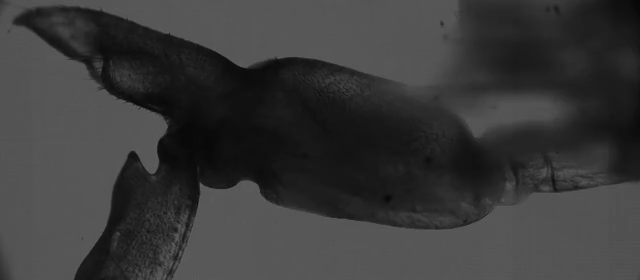
The snapping shrimp, aka the pistol shrimp, is one of the loudest creatures in the ocean, thanks to the snaps produced by its whip-fast claws. And juvenile snapping shrimp are even faster than their fully grown elders, according to a recent paper published in the Journal of Experimental Biology. Juvenile claws accelerate as fast as a bullet shot from a gun when they snap, essentially setting a new acceleration record for a repeated movement performed underwater.
As we've reported previously, the source of that loud snap is an impressive set of asymmetrically sized claws; the larger of the two produces the snap. Each snap also produces a powerful shockwave that can stun or even kill a small fish. That shockwave produces collapsing bubbles that emit a barely visible flash of light—a rare natural example of sonoluminescence.
Scientists believe that the snapping is used for communication, as well as for hunting. A shrimp on the prowl will hide in a burrow or similar obscured spot, extending antennae to detect any passing fish. When it does, the shrimp emerges from its hiding place, pulls back its claw, and lets loose with a powerful snap, producing the deadly shockwave. It can then pull the stunned prey back into the burrow to feed.
In 2020, scientists from the Woods Hole Oceanographic Institution announced the results of their experiments with pistol shrimp. They concluded that as ocean temperatures rise with climate change, snapping shrimp will snap more often and louder than before. That's because shrimp are essentially cold-blooded animals, so their body temperature and activity levels will respond to environmental changes. This would make the global ocean soundscape even noisier. As for why the shrimp seems unaffected by its own powerful snaps, in 2022 scientists concluded that the shrimp is protected by a tiny clear helmet that prevents any significant neural damage by damping the shockwaves.
This latest study focused on the big claw-snapping shrimp Alpheus heterochaelis, native to the western Atlantic Ocean, particularly the Gulf of Mexico. Co-authors Jacob Harrison and Sheila Patek of Duke University are interested in evolutionary biomechanics and wanted to learn more about so-called "latch-mediated spring actuation" (LaMSA)—an umbrella term for the process by which animals like the snapping shrimp use the equivalent of coordinated springs and latches to store and release elastic energy. (It's also how legless larval flies leap through the air and certain plants shoot their seeds like ballistic projectiles.)
They were specifically interested in identifying at what size and age snapping shrimp develop the elements behind their LaMSA mechanism, as well as comparing how the claw kinematics of the juveniles compare with adult snapping shrimp. They collected eggs from female snapping shrimp in Beaufort, South Carolina, carefully scraping the eggs off the pleopods where they are kept during development. The eggs were placed in small plastic containers filled with synthetic seawater, mounted on a shaker table and gently rocked to keep water flowing over the eggs.
All the eggs hatched within 20 days, and the larvae were cared for and monitored until they reached the post larval stage. At that point, they were moved to individual plastic containers and fed brine shrimp eggs. The juvenile snapping shrimp developed claws and started snapping around the one-month mark, and Harrison and Patek selected 20 snapping shrimp from each of four egg clutches for further study.

Next, the researchers induced strikes and took high-speed video of the action with a camera attached to a microscope, ending up with 125 full strikes suitable for tracking the strike kinematics. Initially they filmed at 50,000 frames per second (fps), the usual setting for adult snapping shrimp. But the juveniles' claws were moving too fast, so they switched to 300,000 fps in order to capture the movement.
Harrison and Patek found that even at millimeter-size scales, the juvenile snapping shrimp could snap their claws fast enough to produce cavitation and that those with larger claws could generate cavitation bubbles that lasted longer and traveled farther than shrimp with smaller claws. As for claw acceleration, the authors measured speeds of 580,000 m/s2, 20 times faster than the claw acceleration of adult snapping shrimp. The full snaps were completed in just 300 microseconds.
The authors also compared juvenile strike accelerations with those measured in prior studies for larval mantis shrimp, trap-jaw spiders, slingshot spiders, larval bark beetles, trap-jaw ants, and some 77 species of frog. The trap-jaw ants could match the impressive acceleration of the juvenile snapping shrimp, and Dracula ants and termites have shown even higher accelerations. But all three species are operating in air, not water, and thus are not contending with hydrodynamic drag.
In fact, the only known similarly sized creature with faster accelerations underwater, per a 2006 study, are jellyfish—specifically, the nematocysts in jellyfish tentacles, which hold a barbed or venomous coiled thread that can be released in self-defense or to capture prey. But the authors point out that these nematocysts can only be fired once, like a harpoon, remaining in the target. “These snapping shrimp have these crazy high accelerations,” Harrison told New Scientist, “but they can do it in water, and they’re doing it repeatedly.”
DOI: Journal of Experimental Biology, 2023. 10.1242/jeb.244645 (About DOIs).
Listing image by YouTube/BBC
reader comments
38